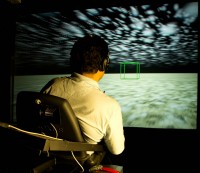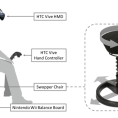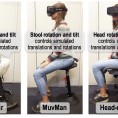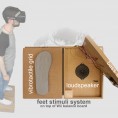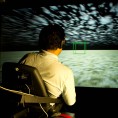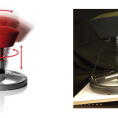Lean and Elegant Motion Cueing in VR
How do we best design locomotion interfaces for VR that provide “enough” physical motion cues (vestibular/proprioceptive) while still being effective, affordable, compact, and safe?
Despite amazing progress in computer graphics and VR displays, most affordable and room-sized VR locomotion interfaces provide only little physical motion cues (e.g., vestibular & proprioceptive cues). To provide a more compelling and natural sensation of being in and moving through virtual environments, and reduced motion sickness and disorientation, we design and evaluate novel approaches towards more embodied yet affordable, safe, and compact locomotion interfaces for VR. In particular, we design and investigate novel user-powered minimal motion cueing interfaces that can enhance self-motion perception in virtual reality.
Video of how such motion cueing could be applied in VR simulations
Below is an example of how one can control the self-motion simulated in Virtual Reality by simply leaning into the direction of intended travel using a leaning chair (Gyroxus). No motors, actuators, or complex motion cueing algorithms needed.


Below are 2 recent posters presented at IEEE VR 2017:
http://ispace.iat.sfu.ca/wp-content/plugins/zotpress/
apa
37904
Freiberg, J., Kitson, A., & Riecke, B. E. (2017). Development and Evaluation of a Hands-Free Motion Cueing Interface for Ground-Based Navigation. Proceedings of IEEE Virtual Reality 2017, 273–274. https://doi.org/10.1109/VR.2017.7892282
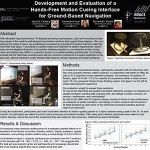
Click to view Poster
http://ispace.iat.sfu.ca/wp-content/plugins/zotpress/
apa
Sorry, there’s no items to display.
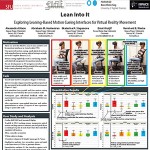
Media Gallery
Related Publications
http://ispace.iat.sfu.ca/wp-content/plugins/zotpress/
37904
Hashemian, Abraham M., and Bernhard E. Riecke. 2017. “Rotate and Lean: Does Leaning toward the Target Direction Improves the Virtual Reality Navigation?” Poster presented at the Second International Workshop on Models and Representations in Spatial Cognition, Tübingen, Germany, April 6.
(Download)
37904
Kitson, Alexandra, Timofey Y. Grechkin, Markus von der Heyde, and Bernhard E. Riecke. 2017. “Navigating Virtual Environments – Do Physical Rotations Aid in Orientation?” Poster presented at the Second International Workshop on Models and Representations in Spatial Cognition, Tübingen, Germany, April 6.
(Download)
37904
Nguyen-Vo, Thinh, Bernhard E. Riecke, and Wolfgang Stuerzlinger. 2017. “Investigating the Effect of Simulated Reference Frames on Spatial Orientation in Virtual Reality.” Poster presented at the Second International Workshop on Models and Representations in Spatial Cognition, Tübingen, Germany, April 6.
(Download)
37904
Nguyen-Vo, Thinh, Bernhard E. Riecke, Wolfgang Stuerzlinger, Duc-Minh Pham, and Ernst Kruijff. 2019. “NaviBoard and NaviChair: Limited Translation Combined with Full Rotation for Efficient Virtual Locomotion.”
IEEE Transactions on Visualization and Computer Graphics (TVCG) 27 (1): 165–77. https://doi.org/10.1109/TVCG.2019.2935730.
(Download)
37904
Hashemian, Abraham M, Ashu Adhikari, Ivan A Aguilar, Ernst Kruijff, Markus von der Heyde, and Bernhard E. Riecke. 2024. “Leaning-Based Interfaces Improve Simultaneous Locomotion and Object Interaction in VR Compared to the Handheld Controller.”
IEEE Transactions on Visualization and Computer Graphics (TVCG) 30 (8): 4665–82. https://doi.org/10.1109/TVCG.2023.3275111.
(Download)
37904
Adhikari, Ashu, Daniel Zielasko, Ivan Aguilar, Alexander Bretin, Ernst Kruijff, Markus von der Heyde, and Bernhard E. Riecke. 2022. “Integrating Continuous and Teleporting VR Locomotion into a Seamless ‘HyperJump’ Paradigm.”
IEEE Transaction on Visualization and Computer Graphics TVCG 29 (12): 5265–81. https://doi.org/10.1109/TVCG.2022.3207157.
(Download)
37904
Adhikari, Ashu, Abraham M. Hashemian, Thinh Nguyen-Vo, Ernst Kruijff, Markus von der Heyde, and Bernhard E. Riecke. 2021. “Lean to Fly: Leaning-Based Embodied Flying Can Improve Performance and User Experience in 3D Navigation.” Frontiers in Virtual Reality 2:1–22. https://doi.org/10.3389/frvir.2021.730334.
37904
Adhikari, Ashu, Bernhard E. Riecke, Abraham M. Hashemian, Thinh Nguyen-Vo, Ernst Kruijff, and Markus von der Heyde. 2021. “Embodied VR Flying Improves Spatial Orientation While Reducing Cybersickness.” Talk presented at the ICSC 2021: 8
th International Conference on Spatial Cognition, Rome, Italy.
https://youtu.be/FbmE4SEISWU.
(Download)
37904
Hashemian, Abraham M., Ashu Adhikari, Alexander Bretin, Ivan Aguilar, Ernst Kruijff, Markus von der Heyde, and Bernhard E. Riecke. 2021. “Is Walking Necessary for Effective Locomotion and Interaction in VR?” In
2021 IEEE Conference on Virtual Reality and 3D User Interfaces Abstracts and Workshops (VRW), 395–96. Lisbon, Portugal: IEEE. https://doi.org/10.1109/VRW52623.2021.00084.
(Download)
37904
Hashemian, Abraham M., Ashu Adhikari, Ernst Kruijff, Markus von der Heyde, and Bernhard E. Riecke. 2021. “Leaning-Based Interfaces Improve Ground-Based VR Locomotion in Reach-the-Target, Follow-the-Path, and Racing Tasks.”
IEEE Transaction on Visualization and Computer Graphics TVCG, 1–22. https://doi.org/10.1109/TVCG.2021.3131422.
(Download)
37904
Riecke, Bernhard E., Ashu Adhikari, Daniel Zielasko, Alexander Bretin, Markus von der Heyde, and Ernst Kruijff. 2021. “HyperJump: Merging Teleporting and Continuous VR Locomotion into One Paradigm.” Talk presented at the ICSC 2021: 8
th International Conference on Spatial Cognition, Rome, Italy.
(Download)
37904
Riecke, Bernhard E, Abraham M Hashemian, Ashu Adhikari, Ivan Aguilar, Ernst Kruijff, and Markus von der Heyde. 2021. “Simultaneous Locomotion and Interaction in VR: Walking > Leaning > Controller.” Talk presented at the ICSC 2021: 8
th International Conference on Spatial Cognition, Rome, Italy.
https://youtu.be/jzoaBAd6gPY.
(Download)
37904
Hashemian, A., M. Lotfaliei, A. Adhikari, E. Kruijff, and Bernhard E. Riecke. 2020. “HeadJoystick: Improving Flying in VR Using a Novel Leaning-Based Interface.” IEEE Transactions on Visualization and Computer Graphics 28 (4): 1792–1809. https://doi.org/10.1109/TVCG.2020.3025084.
37904
Nguyen-Vo, Thinh, Bernhard E. Riecke, Wolfgang Stuerzlinger, Duc-Minh Pham, Ernst Kruijff, and Riecke. 2020. “NaviBoard and NaviChair: Limited Translation Combined with Full Rotation for Efficient Virtual Locomotion.” Talk presented at the IEEE Virtual Reality 2020, Atlanta, GA, USA.
https://youtu.be/JCYL2qVFO6M.
37904
Kruijff, E., & Riecke, B. E. (2018). Navigation Interfaces for Virtual Reality and Gaming: Theory and Practice.
CHI ’18 Extended Abstracts on Human Factors in Computing Systems, 4 pages (half-day course). https://doi.org/10.1145/3170427.3170643
(Download)
37904
Hashemian, Abraham M., Alexandra Kitson, Thinh Nguyen-Vo, Hrvoje Benko, Wolfgang Stuerzlinger, and Bernhard E. Riecke. 2018. “Investigating a Sparse Peripheral Display in a Head-Mounted Display for VR Locomotion.” In
2018 IEEE Conference on Virtual Reality and 3D User Interfaces (VR), 571–72. Reutlingen, Germany: IEEE. https://doi.org/10.1109/VR.2018.8446345.
(Download)
37904
Kruijff, E., & Riecke, B. E. (2018).
Navigation Interfaces for Virtual Reality and Gaming: Theory and Practice. 2 pages (half-day course).
(Download)
37904
Nguyen-Vo, Thinh, Bernhard E. Riecke, and Wolfgang Stuerzlinger. 2018. “Simulated Reference Frame: A Cost-Effective Solution to Improve Spatial Orientation in VR.” In
2018 IEEE Conference on Virtual Reality and 3D User Interfaces (VR), 415–22. Reutlingen, Germany: IEEE. https://doi.org/10.1109/VR.2018.8446383.
(Download)
37904
Nguyen-Vo, Thinh, Bernhard E. Riecke, Wolfgang Stuerzlinger, Duc-Minh Pham, and Ernst Kruijff. 2018. “Do We Need Actual Walking in VR? Leaning with Actual Rotation Might Suffice for Efficient Locomotion.” Poster presented at the Spatial Cognition 2018.
(Download)
37904
Kitson, Alexandra, Thinh Nguyen-Vo, Abraham M. Hashemian, Ekaterina R. Stepanova, and Bernhard E. Riecke. 2017. “A User Study Comparing Two Low-Cost Chair Interfaces for Embodied Virtual Locomotion.” Talk presented at the Psychonomic Society 58th Annual Meeting, Vancouver, BC, Canada, November.
37904
Stepanova, Ekaterina R., Denise Quesnel, Alexandra Kitson, Mirjana Prpa, and Bernhard E. Riecke. 2017. “Virtual Reality as a Tool for Inducing and Understanding Transformative Experiences.” Poster presented at the Psychonomic Society 58
th Annual Meeting, Vancouver, BC, Canada, November.
(Download)
37904
Freiberg, J., Kitson, A., & Riecke, B. E. (2017). Development and Evaluation of a Hands-Free Motion Cueing Interface for Ground-Based Navigation.
Proceedings of IEEE Virtual Reality 2017, 273–274. https://doi.org/10.1109/VR.2017.7892282
(Download)
37904
Hashemian, A. M., & Riecke, B. E. (2017). Leaning-Based 360° Interfaces: Investigating Virtual Reality Navigation Interfaces with Leaning-Based-Translation and Full-Rotation. In S. Lackey & J. Chen (Eds.),
Virtual, Augmented and Mixed Reality (VAMR 2017) (Vol. 10280, pp. 15–32). Springer.
https://youtu.be/7IT9EODJn3c (Download)
37904
Kitson, Alexandra, Abraham M. Hashemian, Ekaterina R. Stepanova, Ernst Kruijff, and Bernhard E. Riecke. 2017. “Comparing Leaning-Based Motion Cueing Interfaces for Virtual Reality Locomotion.” In
Proceedings of IEEE Symposium on 3D User Interfaces 3DUI, 73–82. Los Angeles, CA, USA. https://doi.org/10.1109/3DUI.2017.7893320.
(Download)
37904
Kruijff, E., & Riecke, B. E. (2017). Navigation Interfaces for Virtual Reality and Gaming: Theory and Practice.
Course, 433–434. https://doi.org/10.1109/VR.2017.7892362
(Download)
37904
Nguyen-Vo, T., Riecke, B. E., & Stuerzlinger, W. (2017).
Moving in a Box: Improving Spatial Orientation in Virtual Reality using Simulated Reference Frames. 207–208. https://doi.org/10.1109/3DUI.2017.7893344
(Download)
37904
Kruijff, Ernst, Alexander Marquardt, Christina Trepkowski, Robert Lindemann, Andre Hinkenjann, Jens Maiero, and Bernhard E. Riecke. 2016. “On Your Feet! Enhancing Self-Motion Perception in Leaning-Based Interfaces through Multisensory Stimuli.” In
Proceedings of ACM Symposium on Spatial User Interaction (SUI ’16), 149–58. Tokyo, Japan: ACM. https://doi.org/10.1145/2983310.2985759.
(Download)
37904
Kitson, Alexandra, Timofey Y. Grechkin, M. von der Heyde, and Bernhard E Riecke. 2016. “Effect of Physical Rotations and Gender for Navigation Performance in Virtual Environments.” Poster presented at the International Meeting of the Psychonomic Society, Granada, Spain, May.
http://www.ps2016.org/.
(Download)
37904
Riecke, B. E., Trepkowski, C., & Kruijff, E. (2016).
“Human Joystick”: Enhancing Self-Motion Perception (Linear Vection) by using Upper Body Leaning for Gaming and Virtual Reality (No. 1; ISpaceLab Technical Report, pp. 1–12). Simon Fraser University.
http://ispace.iat.sfu.ca/publications/ (Download)
37904
Freiberg, Jacob. 2015. “Experience Before Construction: Immersive Virtual Reality Design Tools for Architectural Practice.” MSc Thesis, Surrey, BC, Canada: Simon Fraser University.
https://summit.sfu.ca/item/16052.
(Download)
37904
Kitson, Alexandra, Bernhard E. Riecke, Abraham M. Hashemian, and Carman Neustaedter. 2015. “NaviChair: Evaluating an Embodied Interface Using a Pointing Task to Navigate Virtual Reality.” In
Proceedings of the 3rd ACM Symposium on Spatial User Interaction, 123–26. SUI ’15. Los Angeles, CA, USA: ACM. https://doi.org/10.1145/2788940.2788956.
(Download)
37904
Kruijff, Ernst, Bernhard E Riecke, Christina Trepkowski, and Kitson. 2015. “Upper Body Leaning Can Affect Forward Self-Motion Perception in Virtual Environments.” In , 103–12. Los Angeles, CA, USA: ACM. https://doi.org/10.1145/2788940.2788943.
(Download)
37904
Grechkin, Timofey Y., and Bernhard E Riecke. 2014. “Re-Evaluating Benefits of Body-Based Rotational Cues for Maintaining Orientation in Virtual Environments: Men Benefit from Real Rotations, Women Don’t.” In
ACM Symposium on Applied Perception SAP, 99–102. Vancouver, Canada: ACM. https://doi.org/10.1145/2628257.2628275.
(Download)
37904
Feuereissen, Daniel. 2013. “Self-Motion Illusions (Vection) in Virtual Environments: Do Active Control and User– Generated Motion Cueing Enhance Visually Induced Vection?” MSc Thesis, Surrey, BC, Canada: Simon Fraser University.
https://summit.sfu.ca/item/13651.
(Download)
37904
Riecke, Bernhard E., and Daniel Feuereissen. 2012. “To Move or Not to Move: Can Active Control and User-Driven Motion Cueing Enhance Self-Motion Perception (‘Vection’) in Virtual Reality?” In
ACM Symposium on Applied Perception SAP, 17–24. Los Angeles, USA: ACM. https://doi.org/10.1145/2338676.2338680.
(Download)
37904
Riecke, B. E. 2006. “Simple User-Generated Motion Cueing Can Enhance Self-Motion Perception (Vection) in Virtual Reality.” In Proceedings of the ACM Symposium on Virtual Reality Software and Technology, 104–7. Limassol, Cyprus: ACM. https://doi.org/10.1145/1180495.1180517.
